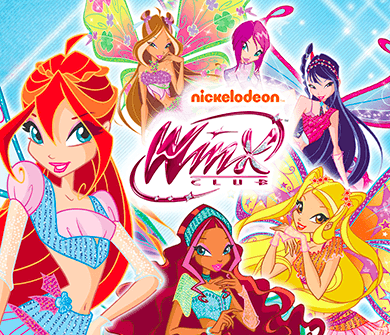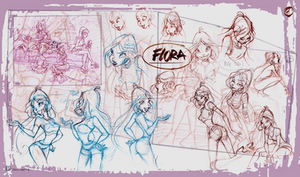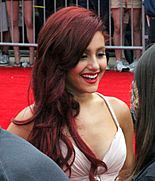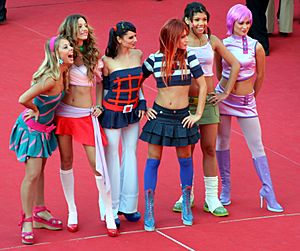Winx Club facts for kids
Quick facts for kids Winx Club |
|
|---|---|
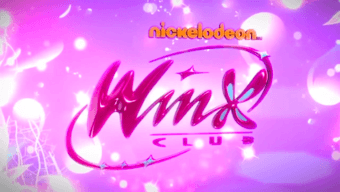 |
|
| Genre | |
| Created by | Iginio Straffi |
| Directed by | Iginio Straffi |
| Composer(s) |
|
| Country of origin |
|
| Original language(s) |
|
| No. of seasons | 8 |
| No. of episodes | 208 (+ 4 hour-long specials) (list of episodes) |
| Production | |
| Executive producer(s) | Joanne Lee Kay Wilson Stallings |
| Running time | 24 minutes |
| Production company(s) | Rainbow (ViacomCBS) RAI Nickelodeon (revived series) |
| Distributor | Rainbow (ViacomCBS) |
| Release | |
| Original network | RAI channels (Italy) Nickelodeon (international) |
| Picture format | NTSC: 480i (original series) HDTV: 1080i (revived series) |
| Audio format | Stereo (original series) Dolby Surround 5.1 (revived series) |
| Original release | Original series: 28 January 2004 – 13 November 2009 Revived series: 27 June 2011 – present |
| Chronology | |
| Related shows |
|
Winx Club is a popular animated show from Italy and the United States. It was created by Iginio Straffi. The series takes place in a magical world filled with fairies, witches, and other mythical creatures. The main character is a fairy warrior named Bloom. She goes to Alfea College to learn and improve her fairy powers.
The show tells an ongoing story that develops over many episodes. Winx Club first aired on January 28, 2004. It quickly became very popular in Italy and on Nickelodeon channels around the world.
Iginio Straffi first planned for the show to have three seasons. But because it was so popular, he decided to continue the story for a fourth season in 2009. Around this time, a big American media company called Viacom (which owns Nickelodeon) became interested in Winx Club. Viacom bought a part of Rainbow SpA, the studio that makes the show. Nickelodeon then started helping to produce new seasons.
Seasons five, six, and seven were made together by Rainbow and Nickelodeon Animation Studio. To reach more viewers in America, Nickelodeon hired famous voice actors, including Elizabeth Gillies and Ariana Grande. They also spent a lot of money on advertising the show. Winx Club became part of Nickelodeon's group of popular shows called Nicktoons.
Since 2010, writers from Nickelodeon's American team have worked with the Italian writers on Winx Club episodes. They wanted to make the show appeal to kids from many different countries. Iginio Straffi said in 2019 that Rainbow and Nickelodeon's teams work very well together. This partnership has led to other shows being made together, like Club 57.
In 2014, the show's budget was cut during its seventh season. Using 3D computer animation and Hollywood voice actors became too expensive. The seventh season still aired on Nickelodeon channels worldwide in 2015. After a break, an eighth season came out in 2019. For this season, Straffi decided to make the show for a younger audience, like preschoolers. Many of the original crew members did not work on season 8. Straffi then focused on other projects, including a live-action show. A live-action version of Winx Club for older teens, called Fate: The Winx Saga, started in 2021.
Contents
Meet the Winx Club Fairies
The series follows a group of girls known as the Winx. They are students at the Alfea College for Fairies. When trouble starts, they transform into powerful fairies to fight bad guys.
The Winx team includes:
- Bloom: The leader with red hair and fire powers.
- Stella: The fairy of the Sun.
- Flora: The fairy of nature.
- Tecna: The fairy of technology.
- Musa: The fairy of music.
- Aisha: The fairy of waves.
- Roxy: The fairy of animals, who sometimes joins the group.
The main male characters are called the Specialists. They go to the Red Fountain school and are also the boyfriends of the Winx fairies. They include:
- Sky: Bloom's fiancé.
- Brandon: Stella's fiancé.
- Helia: Flora's boyfriend.
- Timmy: Tecna's boyfriend.
- Riven: Musa's boyfriend.
Unlike the fairies, the Specialists don't have magic powers. They train to fight using special weapons. The Winx and Specialists often fight against a group of three witches called the Trix. These witches are Icy, Darcy, and Stormy. They used to be students at the Cloud Tower school.
Winx Club is set in a huge universe with many different dimensions. Most of the story happens in the Magic Dimension. This world is hidden from regular people and is home to creatures from European myths, like fairies, witches, and monsters. The main city in this world is Magix, located on a planet of the same name. This is where the three main magic schools are.
Other planets in the Magic Dimension include:
- Domino: Bloom's home planet.
- Solaria: Stella's home planet.
- Linphea: Flora's home planet.
- Zenith: Tecna's home planet.
- Melody: Musa's home planet.
- Andros: Aisha's home planet.
Some episodes also take place on Earth, which is Roxy's home planet and where Bloom grew up.
How Winx Club is Made
Character Design and Style
The show's look mixes Japanese anime with European styles. Iginio Straffi calls this "the trademark Rainbow style." The main characters' final designs are based on Straffi's first drawings. These drawings were inspired by famous people from the early 2000s.
In an interview, Straffi said that Britney Spears inspired Bloom, Cameron Diaz inspired Stella, Jennifer Lopez inspired Flora, Pink inspired Tecna, Lucy Liu inspired Musa, and Beyoncé inspired Aisha. Straffi wanted the fairies to represent "the women of today."
A special team of artists creates the characters' expressions and outfits for each season. They draw about 20 different expressions and positions for each character. To design costumes, they look at recent fashion trends from magazines. Then, they draw many outfits for each character. Simone Borselli, the show's art director, designed most of the early season clothes.
Writing the Stories
The first step in making an episode is writing the script. This can take 5 to 6 months. When the show first started, all the writers were in Italy. After Viacom became a co-owner of Rainbow in 2011, Rainbow's team of 30 writers started working with teams in both Italy and the United States. This international teamwork helps make the stories appealing to viewers from different countries.
Episodes are written with two main storylines:
- A longer story arc that lasts for many episodes.
- A smaller story that finishes by the end of the 22-minute episode.
This way of structuring episodes was inspired by teen dramas and American comics. The show's themes include romance, growing up, and protecting nature (especially in the fifth season).
Animation Process
After the script and character designs are approved, the story goes to storyboard artists. For each 22-minute episode, they create 450 pages of storyboards. These storyboards are used to make an animatic, which is like a moving comic book version of the episode. Dialogue and music are added at this stage to figure out how long each scene should be.
In the first four seasons, the characters' mouths were animated to match the Italian voice actors. In later seasons, the mouth movements matched the English scripts. Many episodes are worked on at the same time because each one takes about two years to finish.
When the first season began, a small team of ten people worked at Rainbow's studio in Recanati. In 2006, Straffi opened a second studio in Rome for computer-animated projects. In seasons five and six, 3D CGI parts were added to the show for the first time. These were animated at the Rome studio. Animating the characters' hair in underwater scenes was especially tricky, so it was done separately.
Voice Actors
In Italy, the voice actors include Letizia Ciampa (Bloom), Perla Liberatori (Stella), Ilaria Latini (Flora), Domitilla D'Amico (Tecna), Gemma Donati (Musa), and Laura Lenghi (Aisha). The actors record their lines in Rome.
The special episodes in 2011 brought in new Hollywood voice actors. Iginio Straffi helped choose the voices for the main characters. The actors recorded their lines in Burbank, California. Molly Quinn voiced Bloom. Nickelodeon told her to use her natural voice, saying, "No, we want voices of real girls this time around."
For the 2011 cast, Viacom hired popular actors to attract American viewers. These stars included Ariana Grande as Diaspro, Elizabeth Gillies as Daphne, Keke Palmer as Aisha, Matt Shively as Sky, and Daniella Monet as Mitzi. These actors voiced characters for the first two Winx movies and seasons three through six. In 2014, the English voice cast moved to New York City to save money and time. Even with new voice actors, the animation for the seventh season continued to match the English scripts.
Music in Winx Club
Iginio Straffi believes music is very important to the series. Original pop songs, similar to those by Britney Spears and Beyoncé, have been recorded in about 40 languages for the show. Michele Bettali, Stefano Carrara, Fabrizio Castania, and Maurizio D'Aniello are frequent composers. Peter Zizzo, a composer from Nickelodeon, joined the team for the fifth season. His music is in seasons five, six, and seven. Each song can take many months to finish. Many songs are sung by Italian singer Elisa Rosselli, who started recording for Winx in 2007.
Nickelodeon also made some live-action music videos for Winx Club. These videos featured stars from other Nickelodeon shows. For example, Elizabeth Gillies from Victorious sang "We Are Believix." This song was also released as a single. Another music video featured Cymphonique Miller from How to Rock singing "Winx, You're Magic Now."
Where to Watch Winx Club
Winx Club first aired in Italy on Rai 2 on January 28, 2004. Later, reruns were shown on Rai Gulp, a channel for children. On September 2, 2010, Nickelodeon announced they would produce new seasons with Rainbow. Nickelodeon showed four one-hour specials that summarized the first two seasons. The first special aired on their main American channel on June 27, 2011. Except for Italy, seasons five, six, and seven were shown on Nickelodeon channels around the world.
During the sixth season in 2014, new episodes moved from Rai 2 to Rai Gulp in Italy. In the United States, they moved from Nickelodeon to Nick Jr.. This change happened because Rainbow decided to aim Winx Club at a younger audience than the earlier seasons. The seventh season was announced by Nickelodeon and Rainbow in April 2014. In Asia, it premiered on Nickelodeon on June 22, 2015. It then aired on Rai Gulp in Italy on September 21, 2015, and on Nick Jr. in the United States on January 10, 2016.
By 2014, Winx Club had been shown in over 150 countries. Some other channels that aired the show included China's CCTV, Ireland's TG4, and 4Kids in the United States. 4Kids edited and changed the original content to make it more local. Iginio Straffi did not like these changes. He said in 2008 that "The Winx fairies cannot talk about boys there. I think this removes something essential."
Winx Club's Impact
Winx Club has been very popular at fan conventions. For example, in 2012 and 2013, Nickelodeon had a big Winx Club presence at San Diego Comic-Con. They gave away new collectibles to fans. Nickelodeon made special dolls for these events, like silver and gold Bloom dolls.
In 2015, a four-day Winx Club fan gathering was held in Jesolo, Italy. Nickelodeon set up a "Fan Wall" for fans worldwide to share messages. In October 2018, an exhibition for the show's fifteenth anniversary was held at the Lucca Comics & Games convention in Tuscany.
Many people have said that Winx Club introduced viewers to stories about strong female characters. A 2019 study found that Winx Club was the fourth most popular Italian show outside of Italy, especially in Russia and the United States.
Giovanna Gallo from Cosmopolitan said in 2018 that the characters have become "real icons of fashion." She also noted how popular the show is with cosplayers. These are people who dress up as the show's characters. Winx Club costumes were even featured on an episode of The Apprentice in Italy.
The Regional Council of Marche, Italy, chose the Winx Club fairies to represent Marche and Italy at the Expo 2010 world's fair in Shanghai. A four-minute video showing the Winx in Marche's tourist spots was made for the Italian Pavilion. In 2015, Italian Prime Minister Matteo Renzi visited Rainbow's studio and called the Winx "a beautiful story of Italian talent."
Winx Club Movies
The Secret of the Lost Kingdom
A Winx Club movie was announced in 2006. The Secret of the Lost Kingdom was released in Italy on November 30, 2007. It first aired on television in the United States on Nickelodeon on March 11, 2012. The movie takes place after the first three seasons. It follows Bloom as she searches for her birth parents and fights the evil Ancestral Witches.
Magical Adventure
A sequel movie was announced in 2009. Winx Club 3D: Magical Adventure was released in Italy on October 29, 2010. It premiered on Nickelodeon in the United States on May 20, 2013. In this movie, Sky asks Bloom to marry him, but Sky's father does not approve. This was the first Italian movie animated in 3D.
In February 2013, Nickelodeon held a special showing of the movie at the TCL Chinese Theatre in Hollywood. Daniella Monet, who voiced Bloom's rival Mitzi, and creator Iginio Straffi attended the premiere.
The Mystery of the Abyss
In late 2010, it was announced that Viacom would help make a new Winx movie. This film, called Winx Club: The Mystery of the Abyss, was released in Italy on September 4, 2014. It first aired on television on Nickelodeon Germany on August 8, 2015. The story follows the Winx as they travel through the Infinite Ocean to rescue Sky, who has been captured by the Trix. Iginio Straffi said this movie is funnier than the first two.
Other Winx Club Shows
PopPixie
PopPixie is a short series that ran for one season in 2011. It features small, cute Pixie characters who were first seen in the second season of Winx Club. After Nickelodeon started working with the main series, PopPixie also began airing on Nickelodeon's channels worldwide.
World of Winx
World of Winx is a spin-off series that started in 2016. Straffi described it as having "more adult graphics" and a story better suited for an older audience than the original series. In this show, the Winx travel to Earth on a secret mission. They are trying to find a kidnapper known as the Talent Thief. 26 episodes were made over two seasons.
Live-Action Adaptation
In 2018, a live-action show for young adults was announced. Filming started in September 2019, with Abigail Cowen playing Bloom. The series first aired on January 22, 2021. The writers for Fate: The Winx Saga were new to the Winx world. They came from other teen dramas like The Vampire Diaries.
Winx Club Merchandise
Iginio Straffi allowed companies to make Winx Club merchandise to help fund his studio's other projects. Over the show's first ten years, more than 6,000 different products were released. As of 2014, Winx Club merchandise sales brought in a lot of money each year. Outside Europe, Mattel made products based on the show until 2012. Then, Nickelodeon chose Jakks Pacific as the new partner for merchandise.
Doll collections based on the characters first came out in January 2004. In Italy, the dolls are made by Witty Toys (part of Rainbow). As of 2016, over 100 different doll collections had been designed, and more than 60 million Winx Club dolls had been sold.
A comic book series has been published since the show began. Over 180 Italian issues have been released. In 2014, 25 million copies of the comics had been sold worldwide. Other books related to the show have also been produced.
Winx Club Games
Several video games based on the show have been made. The first one, Winx Club, was released in 2005. Other video games include Winx Club: The Quest for the Codex (2006), Winx Club: Join the Club (2007), Winx Club: Mission Enchantix (2008), Winx Club: Believix in You (2010), and Winx Club: Magical Fairy Party (2012). A physical trading card game was also released in 2005.
Nickelodeon's website, Nick.com, created many online games based on the show. The Winx Club section on Nick.com became one of the most popular pages on the site. It had 1 million visitors each month in mid-2013.
See also
 In Spanish: Winx Club para niños
In Spanish: Winx Club para niños


